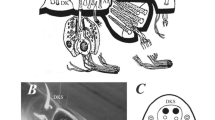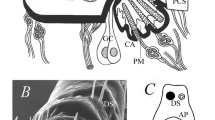Summary
The surface structure and histology of the nymphal and developing pharate adult Haemaphysalis (Kaiseriana) longicornis and of nymphal Boophilus microplus spiracles are described by light and scanning electron microscopy (SEM). Surface pores and ostial aperture in the nymphal spiracular plate are observed by SEM (H. longicornis and B. microplus) and in histological sections (H. longicornis). Formation of the pharate adult tick spiracle starts 2 or 3 days after nymphal detachment from the host and is completed on day 14 or 15 when the adult is ready to emerge. During this interval, hypodermal cells beneath the nymphal spiracular plate differentiate into the pharate adult spiracle components and form a thickened, folded edge around the ostial aperture, which contains detached nymphal tracheae. The developing adult spiracular plate shows goblets and interpedicellar spaces and a lip-guarded ostium. The molting process of the adult tick spiracle is more simple than that of insects having specialised spiracular plates.
Similar content being viewed by others
References
Arthur, D. R.: The morphology of the British Prostriata, with particular reference to Ixodes hexagonous Leach. III. Parasitology 46, 261–307 (1956)
Chapman, R. F.: The insects, structure and function, 819 pp. London: The English Universities Press Ltd. 1969
Hinton, H. E.: On the reduction of functional spiracles in the aquatic larvae of the Holometabola, with notes on the moulting process of spiracles. Trans. roy. Ent. Soc. Lond. 98, 449–473 (1947)
Hinton, H. E.: The structure of the spiracles of the cattle tick, Boophilus microplus. Aust. J. Zool. 15, 941–945 (1967a)
Hinton, H. E.: Structure and ecdysial process of the larval spiracles of the Scarabaeoidea, with special reference to those of Lepidoderma. Aust. J. Zool. 15, 947–953 (1967b)
Hinton, H. E.: Some neglected phases in metamorphosis. Proc. roy. Ent. Soc. Lond. 35, 55–64 (1971)
Hoogstraal, H., Roberts, F. H. S., Kohls, G. M., Tipton, F. J.: Review of Haemaphysalis (Kaiseriana) longicornis Neumann (resurrected) of Australia, New Zealand, New Caledonia, Fiji, Japan, Korea, and northeastern China and USSR, and its parthenogenetic and bisexual populations (Ixodoidea, Ixodidae). J. Parasit. 54, 1197–1213 (1968)
Jenkin, P. M., Hinton, H. E.: Apolysis in arthropod moulting cycles. Nature (Lond.) 211, 871 (1966)
Nuttall, G. H. F., Cooper, W. F., Robinson, L. E.: On the structure of the spiracles of a tick, Haemaphysalis punctata Canestrini and Fanzago. Parasitology 1, 347–351 (1908)
Roshdy, M. A., Axtell, R. C.: Ultrastructure of arthropod sensory structures. Scanning electron microscopy of Haemaphysalis ticks. Technical report No. 3. Virginia, U.S.A.: Office of Naval Research, Naval Biology Program 1972
Roshdy, M. A., Hefnawy, T.: The functional morphology of Haemaphysalis spiracles (Ixodoidea: Ixodidae). Z. Parasitenk. 42, 1–10 (1973)
Sixl, W., Dengg, E., Walfinger, H.: Rasterelektronenoptische Untersuchungen bei Zecken. III. Die Stigmen von Ixodes ricinus Linné, Ixodes canisuga Johnston, Ixodes redikorzevi Olenev, Dermacentor marginatus Sulzer, Argas reflexus Latreille und Ornithodoros papillipes Birula. Arch. Sci. Geneva 24, 403–407 (1971)
Tenquist, J. D., Wright, D. F., Skyrme, H. P.: Measures to control cattle tick. N.Z. J. Agric. 19, 21 (1973)
Wooley, T. A.: Scanning electron microscopy of the respiratory apparatus of ticks. Trans. Amer. micr. Soc. 91, 348–363 (1972)
Author information
Authors and Affiliations
Additional information
From Research Projects MR041.09.01-0037 A 6GI and MF51.524. 009-3010B F61, Bureau of Medicine and Surgery, Department of the Navy, Washington, D.C. The opinions and assertions contained herein are the private ones of the author and are not to be construed as official or as reflecting the views of the Department of the Navy or of the naval service at large. This study was assisted by Agreement 03-005-1 between the National Institute of Allergy and Infectious Diseases (National Institutes of Health) and NAMRU-3, by a special grant from the office of Naval Research (ONR), and by ONR contract N00014-70-A-0120-001 (R. C. Axtell, principal investigator).
Rights and permissions
About this article
Cite this article
Roshdy, M.A. Structure of the nymphal spiracle and its formation in the pharate adult Haemaphysalis (Kaiseriana) longicornis neumann (ixodoidea: Ixodidae). Z. F. Parasitenkunde 44, 1–14 (1974). https://doi.org/10.1007/BF00328827
Received:
Issue Date:
DOI: https://doi.org/10.1007/BF00328827




